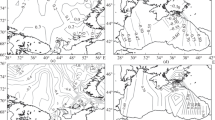Abstract
Seasonal average distribution of mesoscale anomalies of the Black Sea surface temperature (SST) and features of their localization for various seasons are considered. The area of cold SST anomalies is detected in open western and central parts of the sea. It is shown that an autumn season makes a major contribution to the formation of long-lived mesoscale cold anomalies in the central parts of the sea. The key features are reproduced and the main physical mechanism of rapid development of a cold anomaly is determined in the numerical experiment using the WRF-ARW model with the attached 3dPWP unit. It is shown that fast cooling occurs mainly due to the entrainment of cold waters from a thermocline, which results in the abrupt deepening of the upper quasi-homogeneous layer.
Similar content being viewed by others
References
A. M. Anisimov, D. A. Yarovaya, and V. S. Barabanov, “Reanalysis of atmospheric circulation for the Black Sea–Caspian region,” Morsk Gidrofiz. Zh., No. 4, 14–28 (2015).
A. Gill, Atmosphere and Ocean Dynamics (Academic, New York, 1982; Mir, Moscow, 1986).
Yu. N. Goryachkin, Characteristics of Coastal Upwelling near the Southern Coast of Crimea (EKOSIGIDROFIZIKA, Sevastopol, 2005), pp. 30–31.
V. V. Efimov and D. A. Yarovaya, “Numerical simulation of air convection in the atmosphere during the invasion of cold air over the Black Sea,” Izv., Atmos. Ocean. Phys. 50 (6), 610–620 (2014).
A. G. Zatsepin, V. V. Kremenetskiy, V. B. Piotukh, et al., “Formation of the coastal current in the Black Sea caused by spatially inhomogeneous wind forcing upon the upper quasi-homogeneous layer,” Oceanology (Engl. Transl.) 48 (2), 159–174 (2008).
V. A. Ivanov and V. V. Belokopytov, The Black Sea Oceanography (NAN Ukrainy, Sevastopol, 2011) [In Russian].
M. M. Ovchinnikov and Yu. I. Popov, “Formation of the cold intermediate layer in the Black Sea,” Okeanologiya (Moscow) 27 (5), 739–746 (1987).
M. M. Ovchinnikov and Yu. I. Popov, “Specific features of the formation of the cold intermediate layer in the Black Sea under experimental winter conditions,” Tr. GOIN, No. 190, 132–151 (1990).
R. J. Greatbatch, “On the role played by upwelling of water in lowering sea surface temperature during passage of storm,” J. Geophys. Res. 90 (C6), 11751–11755 (1985).
W. G. Large, J. C. McWilliams, and P. P. Miller, “Upper ocean thermal response to strong autumnal forcing of the North–East Pacific,” J. Phys. Oceanogr. 16, 1524–1541 (1986).
J. F. Price, R. A. Weller, and R. Pinkel, “Diurnal cycling: Observations and models of the upper ocean response to diurnal heating, cooling, and wind mixing,” J. Geophys. Res. 91 (C7), 8411–8427 (1986).
J. F. Price, T. B. Sanford, and G. Z. Forristoll, “Forced stage response to a moving hurricane,” J. Phys. Oceanogr. 24, 233–260 (1994).
R. W. Reynolds, M. S. Thomas, L. Chunying, et al., “Daily high resolution blended analyses for sea surface temperature,” J. Clim. 20, 5473–5496 (2007).
M. M. Rienecker, M. J. Suarez, R. Gelaro, et al., “MERRA: NASA’s modern-era retrospective analysis for research and applications,” J. Clim. 24, 3624–3648 (2011).
W. C. Skamarock, J. B. Klemp, J. Dudhia, et al., A description of the Advanced Research WRF version 2, NCAR Tech. Note 468 + STR, 2005.
Y. Xue, T. M. Smith, and R. W. Reynolds, “Interdecadal changes of 30-yr SST normals during 1871–2000,” J. Clim. 16, 1601–1612 (2003).
Author information
Authors and Affiliations
Corresponding author
Additional information
Original Russian Text © V.V. Efimov, V.S. Barabanov, 2017, published in Izvestiya Rossiiskoi Akademii Nauk, Fizika Atmosfery i Okeana, 2017, Vol. 53, No. 3, pp. 389–398.
Rights and permissions
About this article
Cite this article
Efimov, V.V., Barabanov, V.S. Anomalies of the Black Sea surface temperature and modeling of intense cold anomaly formation in September 2014. Izv. Atmos. Ocean. Phys. 53, 343–351 (2017). https://doi.org/10.1134/S0001433817030057
Received:
Accepted:
Published:
Issue Date:
DOI: https://doi.org/10.1134/S0001433817030057




